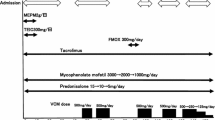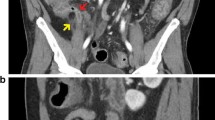Abstract
Clostridium difficile (C. difficile) pseudomembraneous colitis was diagnosed in a 13-year-old boy with Hodgkin’s disease 3 months after autologous bone marrow transplantation. Hematopoiesis was fully reconstituted at the time. C. difficile infection occurred after gall bladder empyema had been treated conservatively with i.v. antibiotics and prophylactic 4-week administration of oral amoxicillin. C. difficile colitis was diagnosed early and intensive supportive therapy combined with administration of i.v. and subsequently oral vancomycin therapy failed. It is a phenomenon rarely seen and successful eradication of the clostridium infection was only achieved by a combination of higher dose vancomycin with metronidazole. During the post-colitis recovery the patient experienced a relapse of Hodgkin’s disease and died following further surgical intervention 137 days post-transplantation.
Similar content being viewed by others
Author information
Authors and Affiliations
Rights and permissions
About this article
Cite this article
Kavan, P., Sochor, M., Nyc, O. et al. Pseudomembraneous clostridium after autologous bone marrow transplantation. Bone Marrow Transplant 21, 521–523 (1998). https://doi.org/10.1038/sj.bmt.1701117
Received:
Accepted:
Published:
Issue Date:
DOI: https://doi.org/10.1038/sj.bmt.1701117
- Springer Nature Limited
Keywords
This article is cited by
-
GI complications in pediatric patients post-BMT
Bone Marrow Transplantation (2005)
-
Rarity of toxigenic Clostridium difficile infections after hematopoietic stem cell transplantation: implications for symptomatic management of diarrhea
Bone Marrow Transplantation (2002)
-
High prevalence of diarrhea but infrequency of documented Clostridium difficile in autologous peripheral blood progenitor cell transplant recipients
Bone Marrow Transplantation (2000)




